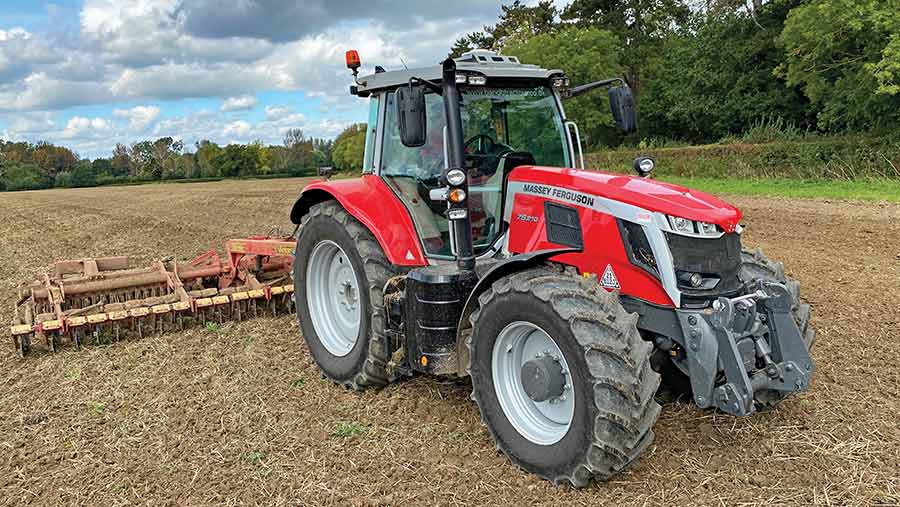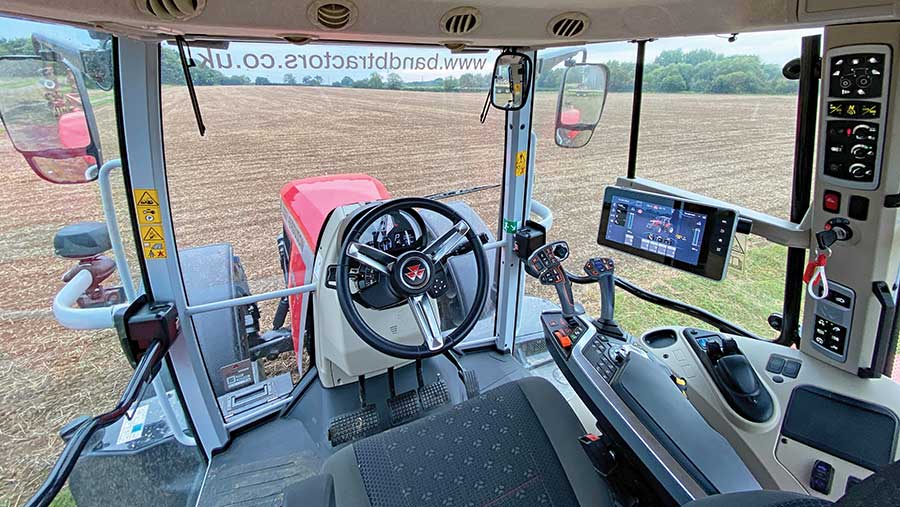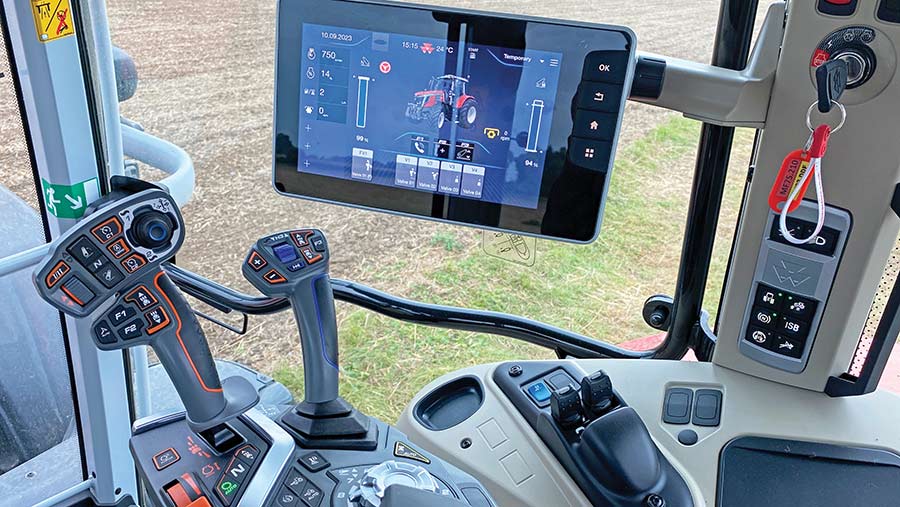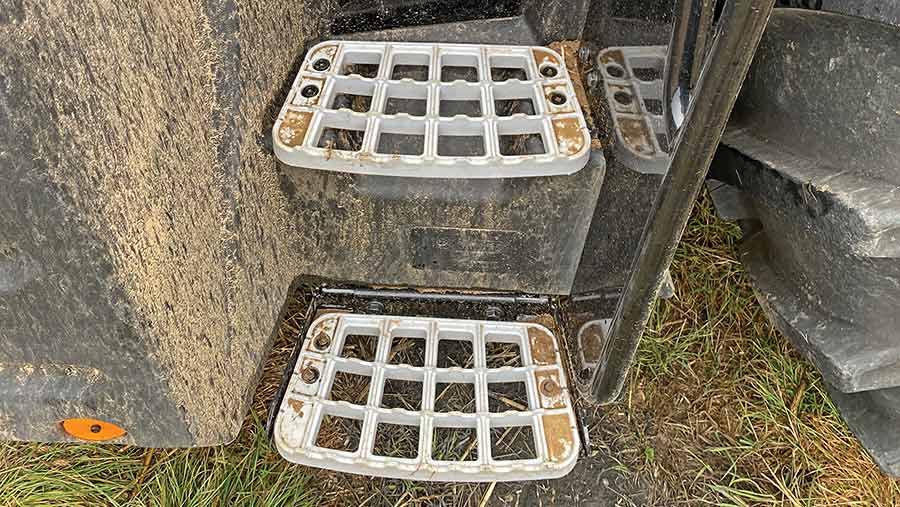On test: Massey Ferguson 7S.210 proves versatile all-rounder

A boom in aftermarket tuning chips and remapping software has created a swarm of performance-enhanced tractors that churn out far more horsepower than their makers ever intended.
On the one hand, this has helped canny buyers get more firepower for their money, but it’s also highlighted how useful a neat 160hp tractor can be when it has 200hp-plus up front.
See also: On test: John Deere’s 6R 185 tractor
Unsurprisingly, manufacturers are none too keen on this unofficial tinkering.
But with demand for these tractors steadily increasing, they’re gradually coming around to the tuners’ way of thinking; albeit in an above-board fashion that doesn’t void any warranties.
John Deere has joined the club, tightening some electronic screws on the popular 6R 155 to create the 204hp 6R 185, and recently Massey Ferguson has followed suit with its flagship 7S.210.
Like its green rival, this is physically identical to lesser-powered models, save for some tweaks to the software that governs how hard the engine works.
Max power output has been hiked to 210hp, up 20hp from the 7S.190, but boost is pegged at the same 220hp on both.
For pto and transport work this means there won’t be a huge difference between the two, but the 210 should come into its own for heavy draft.
When it was launched in 2021, the new nomenclature and retro primer-grey paintwork made the 7S look significantly different to the 7700S tractors that preceded it.
But unlike the radical redesign of the larger 8S range, the performance and structural updates have been comparatively minor.
Massey Ferguson 7S.210 Dyna-VT Exclusive specs
- Engine Agco Power, 6.6-litre, six-cylinder
- Max/boosted power 210/220hp
- Max/boosted torque@1,500rpm 860Nm/925Nm
- Transmission Dyna VT two-range stepless
- Lift capacity 9,600kg rear, 4,000kg front
- Wheelbase 2.88m
- Turning circle 9.86m
- Minimum weight 6,300kg
- Gross vehicle weight 14,000kg
- Approx on-farm price £146,700 including three-year/2,400-hour warranty
Cab updates
This starts with the cab, which is the same six-pillar design MF has been using for donkey’s years.
Some people love it, particularly the curved rear-quarter opening windows, but there’s no getting away from the fact that it’s decidedly dated compared to what most of the competition has on offer.
You don’t get many high-spec tractor interiors with exposed metal framework these days, and there’s precious little space to fit gear and refreshments for long days in the seat.
It begs the question as to how long it will be before the 7S is treated to a workspace more akin to that fitted on the 8S, which addresses most of the above grumbles.

The cab frame looks dated © MAG/Oliver Mark
It’s happier news on the controls front though, particularly in this top-of-the-range Exclusive spec tractor.
Here, designers have spruced things up with a new armrest that draws in formerly scattered controls so they’re poised under the driver’s fingertips.
An improved joystick has also been introduced, complete with a scroll wheel for adjusting cruise speed – this was formerly lumped over on the right console – a mini thumb controller for operating two spool valves and a couple of customisable F buttons.
There have been tweaks to the Datatronic 5 screen too, making it simpler to navigate and sharper to look at.
It’s still mounted on a chunky bracket off the side pillar though, which is slightly less convenient than the armrest position adopted by most makers.
Plus, it reduces the options for mounting other control boxes. Not all switchgear has been logically placed either, with two lone spool paddles still isolated over on the right-hand console.

Armrest controls have been brought more up to date © MAG/Oliver Mark
In our view, it would have been more sensible to group all the hydraulic controls in a single bank on the armrest.
But Massey has been limited to how wide it can make the armrest, as the old cab has a large console on the right side that gets in the way.
And because this is now largely redundant, it’s peppered with blanking plates covering holes where switches once resided.
Other updates include a more powerful but thunderously noisy air conditioning system, a new steering wheel and the option of adding a fancier seat with lateral shock absorbers and swish sounding “dynamic” damping.
One further change is a switch to individual plastic steps up to the cab. These are less likely to get bent, they won’t corrode when slathered in slurry and they’re cheaper to replace if they do break.

Plastic steps replace rust-prone metal ones © MAG/Oliver Mark
More power, simpler to drive
Two of the best, and most important elements, of the 7S are its engine and transmission.
The former is the same 6.6-litre, six-cylinder Agco Power block as used in the 7700 series, which harks back to the Sisu days.
It’s always been a solid performer for both power and reliability and manages to meet the Stage 5 emissions standard without the need for exhaust gas recirculation, a diesel particulate filter or a variable-geometry turbo.
By gradually cranking up the power and keeping the same compact 2.88m chassis, MF has created a gusty tractor for its size.
This means it’s got the minerals for pulling a heavy cultivator one day, without looking ridiculous running a tedder the next.
It’s a similar story with the proven Dyna-VT transmission sourced from fellow Agco brand Fendt.
This set the benchmark for other continuously variable boxes to follow, but it is now getting long in the tooth and its German stablemate has moved on to a posher setup.
There have been no mechanical alterations, but Massey has made the transmission simpler to operate.
The main change is allowing it to be driven in stick or pedal mode without having to press a button – all drivers have to do is make sure automatic mode is selected.
Manual mode works in the time-honoured fashion of putting speed control on the joystick and engine revs on the foot pedal or hand throttle.
The result of this rework is that that it’s far easier for uninitiated operators to hop on and drive.
Weight lifter
Despite its modest stature and weight, the 7S can lift 9.6t on the rear linkage, 4t on the front and it has a generous gross vehicle weight of 14t.
All this adds to its versatility, meaning it can be light and agile when required, but also carry heavy loads and be fitted with plenty of ballast to give extra traction.
As for the hydraulics, the back end can accommodate up to four spool valves plus Power Beyond and there’s the option of having two at the front.
FW verdict
The 7S might have a completely different look to the 7700S tractors that went before, but grey paintwork aside, the fundamentals are the same.
Massey has brought in some nice updates though, making some significant improvements to the controls, refreshing the software in the screen and making it simpler to drive.
The Agco Power engine and Dyna-VT transmission have long been some of its best attributes and, by tweaking the power, Massey has created a powerful machine for its size.
Max output is now 10hp more than the old 7720S, which looks a far bigger and clumsier machine alongside.
Letting the side down slightly is the dated cab frame which lacks the refinement offered by its peers and is short on space.
It’s been ripe for a refresh for years, and with the 8S getting such a radical redesign, hopefully MF will address this soon.
Likes and gripes
Likes
- Compact for power
- Slicker controls than predecessor
- Proven engine and transmission
Gripes
- Small, dated cab frame
- Pillar rather than armrest-mounted screen
- Spool levers not in one place
Rest of the range
Unlike the old 7700 range, which included both small and large-chassis tractors, the five-model 7S series only has the former.
Each is fitted with the same 6.6-litre engine, max power output starts at 155hp in the 7S.155, and all are available with a Dyna-VT transmission.
However, those up to the 180hp 7S.180 can also be had with a Dyna-6 semi-powershift gearbox.
A broader range of specs are also available for these smaller tractors so that there’s the option of dialling down the level of technology and fitting simple manual spool levers.
The larger-frame 8S kicks off with the 295hp 8S.205, so there’s a small overlap in power between the two ranges.

